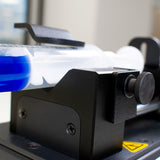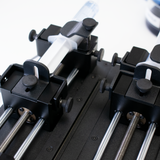Syringe pump vs Infusion pump

Syringe pumps and infusion pumps are two primary instruments used for accurate, continuous, and controlled delivery of fluids. While they might share purposes, the devices differ in design, function, and use cases. Both devices have their advantages and disadvantages and the choice between them depends on the volume of fluid, required accuracy and application environment.
Syringe pump vs Infusion pump
Syringe pump and infusion pump are designed to deliver fluid continuously and accurately. Syringe pumps offer significant advantage for manual administration as well as automated delivery and consistent intervals. They are used in the research settings to minimize fluid delivery errors with precise dosing of small volumes. There are several types of syringe pumps, including medical and laboratory ones. The main difference between them is the method of the fluid displacement.
While syringe pumps are used in volumetric infusion systems, such as micro dosing, infusion pumps are often called volume pumps and are widely used for accurate and safe drug delivery. Syringe pumps are advantageous for micro-infusion as they offer higher accuracy in small-volume delivery, flexible dispensing, reduce flow rate pulsation and can be placed on table tops.
| Syringe Pump | Infusion Pump | |
|---|---|---|
| Mechanism | Pushes fluid from a syringe | Pumps fluid from an IV bag or container |
| Precision | Extremely high, ideal for micro dosing | Moderate, suitable for larger volumes |
| Capacity | Low (microlitres to millilitres) | High (millilitres to litres) |
| Flow rate | Narrow range, precise control | Wide flow rate range |
| Applications | Research, microfluidics, drug testing | Clinical settings |
| Advantages | High precision, tabletop-friendly, low pulsation | Higher volume, fewer restrictions on fluid types |
| Uses | Micro dosing, scientific research | Bulk medication / nutrient delivery |
Infusion pumps
Infusion pumps are specific medical equipment designed to deliver precise amounts of liquid substances. These substances may include medications and nutrients and are delivered directly into patients arm. The main advantage of infusion pumps is their programmability. Medical professionals can set the flow rate and duration. While the infusion pumps are most commonly found in clinical settings, they may occasionally be used in biological and medical research. Infusion pumps operate via an electronic or mechanical motor that moves fluid from a reservoir through tubing and into a needleless catheter connected to the patient.
Main components
- Pump mechanism drives the flow of fluids
- Reservoir holds the fluid source, such as an IV bag
- Flow control system regulates the rate at which the fluid is delivered
- Control interface allows the user to set parameters such as infusion rate, volume to be infused, and alarm limits
- Display provides real-time feedback
- Microcontroller or control circuitry processes the user input and controls the operation of the pump
- Power supply
- Enclosure houses all the internal components of the infusion pump and provides protection against environmental factors and contamination
Applications
While infusion pumps are widely used in clinical settings, they do have some applications in animal and laboratory studies. In animal research, infusion pumps are used for precise and controlled administration of drugs. In micro dialysis experiments they deliver perfusion fluid at a constant rate to collect small-molecule analytes from extracellular fluid. When used in physiological experiments, infusion pumps facilitate continuous fluid or substance delivery. They are also employed in the perfusion of isolated organs such as heart or kidneys. This provides a controlled environment to study organ function, metabolism, and responses to pharmacological interventions.
Syringe pumps
When compared to infusion pumps, syringe pumps have been designed to handle smaller volumes. They are equipped with advanced programmable features such as connectivity to computer systems for data analysis and automation. In research and industrial settings, syringe pumps are used not only for their accuracy but also their portability and flexibility. Due to their high accuracy, syringe pumps are used in fields such as pharmaceutical research, chemical development, and other areas which require precise, low-volume fluid delivery. Common applications within these fields include microfluidics, mass spectrometry and high-performance liquid chromatography (HPLC).
Beyond basic infusion, syringe pumps provide infuse and withdrawal systems, multi-channel syringe configurations, and high-pressure dosing models. Syringe pumps can be categorised based on their application (medical vs non-medical), structure (split vs combination), number of channels (single vs multi), and working models (single-push, push-pull, or bi-directional push-pull).
Main components
- Syringe holder or clamp that securely holds the syringe in place
- Drive mechanism is responsible for pushing the plunger of the syringe to dispense the fluid
- Control interface allows the user to input parameters such as flow rate, volume, and infusion rate
- Motor provides mechanical power needed to drive the syringe plunger
- Display provides feedback to the user showing parameters such as current flow rate, volume delivered, any alarms or error messages
- Microcontroller or control circuitry processes the user input and controls the operation
- Power supply
- Enclosure houses all the internal components
Applications in laboratory research
Syringe pumps offer a wide range of applications with unmatched precision in microfluidics, electrospinning, mass spectrometry and industrial transport. Laboratory syringe pumps feature higher precision when compared to their medical variants, with 50 pounds to 6 tons of pushing force. In chemistry, they are necessary for chemical synthesis, as they enable simultaneous delivery of multiple reagents in flow chemistry, micro reaction technology, and automated synthesis. In cell biology, syringe pumps are used fore precise dosing of fluids to maintain cell integrity and experimental accuracy.
Syringe Pump

Learn More
 What is a Syringe Pump?
What is a Syringe Pump?
Syringe pumps, or syringe drivers, are motorized devices that accurately control the movement of fluid from a syringe by mechanically inserting or retracting the plunger. Stepper motors accurately move the platform attached to the plunger of the syringe while the body of the syringe is held steady so that the only movement is from the action of the motor.
Read more... Microstepping Technology in Syringe Pumps
Microstepping Technology in Syringe Pumps
Microstepping is a technique used when controlling the motion of stepper motor, it allows for an increased resolution compared to standard full-step operation.
Read more...